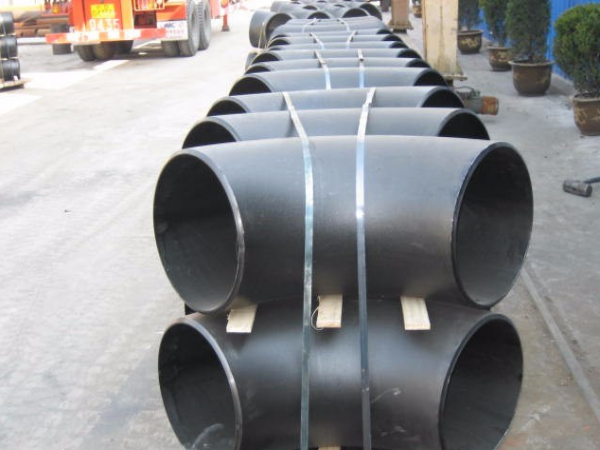Load study of seamless elbow
Local thinning is a common defect of elbows, but the research on such defects at home and abroad is mainly for straight pipes, and there are few literature reports on the research on local thinning of elbows. In this paper, through detailed finite element calculations and theoretical analysis, the influence of local thinning on the ultimate bearing capacity of the elbow under the action of internal pressure and bending moment, and the mutual interference effect and bending moment of multiple local thinning under the action of internal pressure are studied. The strengthening effect of the lower straight pipe on the ultimate load of the elbow has been verified by some experiments, and the following research results have been obtained:

1. Using the finite element method to systematically analyze and calculate the ultimate load of the locally thinned elbow under the action of internal pressure, it is concluded that the ultimate pressure of the locally thinned elbow is different from that of the locally thinned straight pipe, and the limit load of the elbow is different from that of the locally thinned straight pipe. The pressure depends not only on the size of the local thinning, but also on the position of the local thinning and the bending radius. If the calculation method of the local thinning straight pipe is used to evaluate the elbow, the result will be unsafe or too conservative; at the same time, the thinning width The influence on the ultimate load cannot be ignored. On the basis of finite element analysis, the calculation formula of the ultimate pressure of the locally thinned elbow is given. The calculation results of the formula are quite consistent with the finite element calculation and experimental results and are safe. The calculation formula can be actually applied to the locally thinned elbow. Safety assessment supplements the blank of this research.
2. Through finite element analysis, the mutual interference effect between multiple local thinnings under internal pressure is studied, and the research shows that the mutual influence of multiple local thinnings is not only related to the spacing, but also related to the thinning depth. It is pointed out that when the thinning depth is shallow, the axial local thinning spacing is greater than 2 times the wall thickness, and the ultimate load of double local thinning is basically the same as that of single local thinning; when the thinning depth is deep, the axial local thinning When the spacing is greater than 4 times the wall thickness, the ultimate load of double local thinning is basically the same as that of single local thinning, which complements the shortcomings of existing research.
3. Through the finite element calculation, the strengthening effect of the connected straight pipe on the ultimate bending moment of the elbow is studied, and it is pointed out that the straight pipe connected with the elbow will increase the ultimate bending moment of the elbow. When the bending radius is different, the ultimate load of the elbow The amount of increase varies. When the length of the connected straight pipe is greater than 3 times the pipe diameter, the strengthening effect of the straight pipe on the elbow no longer increases. This study complements the lack of research on the strengthening effect of straight pipes on elbows.
4. The influence of local thinning on the ultimate bending moment of the elbow has been studied in detail through finite element analysis, and it is concluded that the ultimate bending moment of the locally thinned elbow under the action of in-plane bending moment is related to the thinning position, thinning size and bending radius . Research shows that under the action of bending moment, the effect of geometric nonlinearity is significant. Based on the finite element analysis of local thinning and large deformation of the inner wall, the calculation formula for the ultimate bending moment of the locally thinned elbow under the action of in-plane bending moment is given. The calculation results can reflect the finite element calculation results more accurately and conservatively. and is consistent with the experimental results. This study fills a gap in this field.
Material classification of seamless elbows
1. Austenitic stainless steel The matrix is mainly composed of austenite structure (γ phase) with a face-centered cubic structure, and it is non-magnetic. It is mainly strengthened by cold working (and may lead to certain magnetic properties).
2. The austenitic-ferritic (duplex) stainless steel matrix has both austenite and ferrite two-phase structure (the content of the lesser phase is generally greater than 15%). It is magnetic and can be strengthened by cold working of stainless steel.
3. Ferritic stainless steel The matrix is mainly ferrite structure (α phase) with a body-centered cubic crystal structure, which is magnetic and generally cannot be hardened by heat treatment, but it can be slightly strengthened by cold working.
4. Martensitic stainless steel The matrix is martensitic, magnetic, and its mechanical properties can be adjusted by heat treatment.
5. Precipitation hardening stainless steel The matrix is austenite or martensite, and can be hardened (strengthened) by precipitation hardening (also known as age hardening).
6. Stainless steel 1Cr18Ni9Ti 0Cr18Ni9 00Cr19Ni10 0Cr17Ni12Mo2Ti 00Cr17Ni14Mo2 304 304L 316 316L, etc. 3. Stainless steel elbows have certain corrosion resistance (oxidative acid, organic acid, cavitation), heat resistance and wear resistance. Usually used in power plants, chemicals, petroleum and other equipment materials. The weldability of stainless steel elbows is poor, and attention should be paid to the welding process, heat treatment conditions and selection of suitable welding electrodes.













 Eastern Steel Manufacturing Co.,Ltd not only improve product production and sales services, but also provide additional value-added services. As long as you need, we can complete your specific needs together.
Eastern Steel Manufacturing Co.,Ltd not only improve product production and sales services, but also provide additional value-added services. As long as you need, we can complete your specific needs together.










